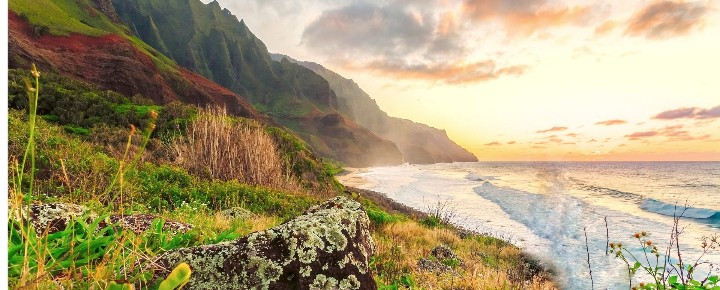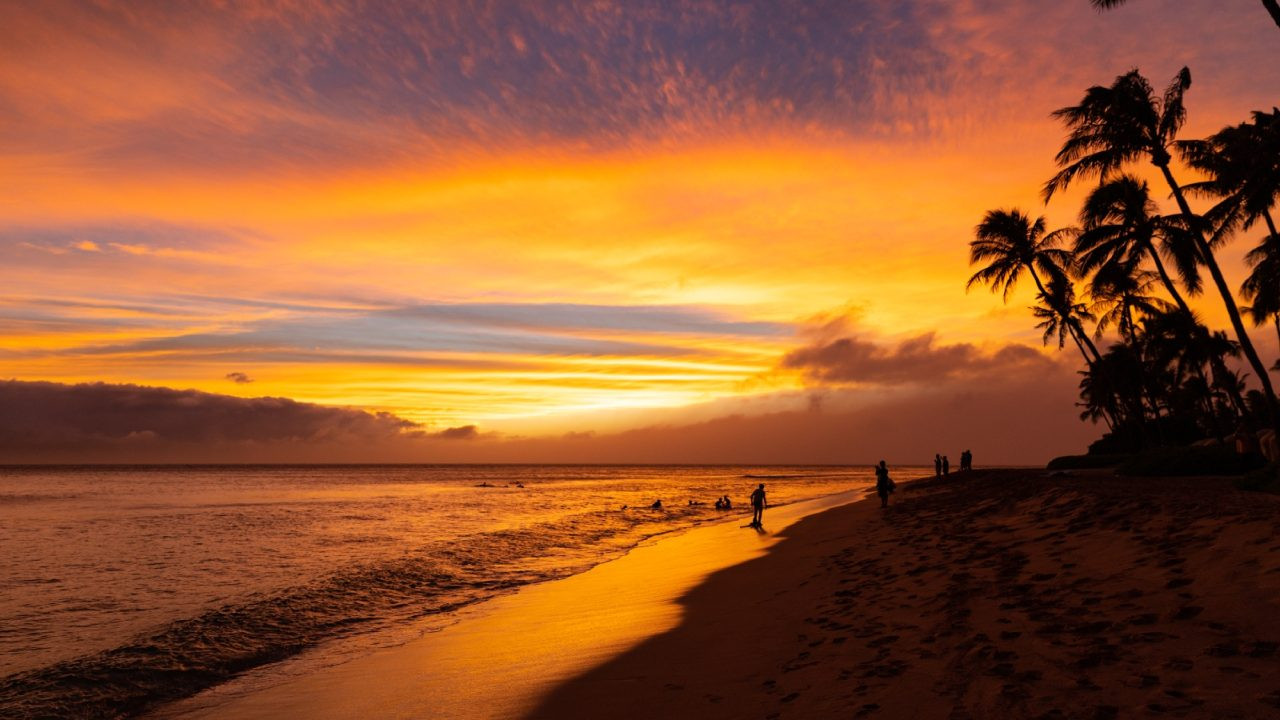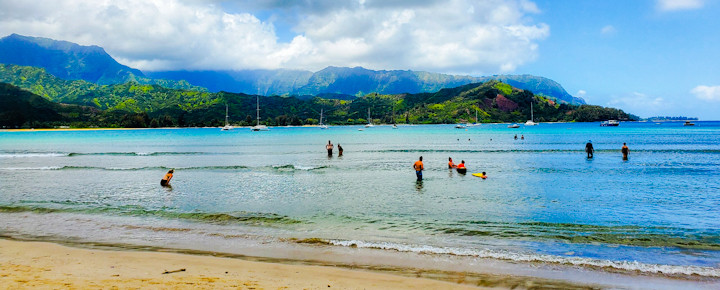Are you planning a trip to Vietnam and looking for reliable travel services? Or are you just curious about the future of tourism in destinations like Hawaii? This article addresses the critical question: How Long Can Hawaii Survive Without Tourism? We’ll explore the challenges Hawaii faces and how it’s adapting, while also highlighting how SIXT.VN can help you navigate your travel needs in Vietnam. Discover the strategies Hawaii is employing to balance its economy and environment, and find out how SIXT.VN provides convenient solutions for your Vietnam travel plans, including airport transfers, hotel bookings, and guided tours.
1. What Are The Key Challenges Facing Hawaii’s Tourism Industry?
Hawaii’s tourism industry faces significant challenges including over-tourism, environmental degradation, and economic vulnerability. The dependence on tourism has strained resources and impacted the quality of life for residents.
Hawaii’s reliance on tourism has created a fragile economic ecosystem. While tourism brings in revenue, it also leads to:
- Environmental Strain: Overcrowding at popular sites like Hanauma Bay and the Road to Hana damages natural resources.
- Quality of Life Issues: Residents face increased costs of living and crowded public spaces.
- Economic Vulnerability: Economic shocks, such as pandemics, can devastate the tourism-dependent economy.
The need for sustainable practices is evident. According to the Hawaii Tourism Authority, sustainable tourism focuses on balancing the needs of visitors with those of the environment, culture, and local communities.
2. How Did Hawaii Transform During Covid-19 Without Tourism?
During the COVID-19 pandemic, Hawaii experienced a remarkable transformation. With the absence of tourists, the environment began to regenerate, and residents enjoyed a sense of tranquility and access to spaces usually crowded.
The lack of tourists allowed natural environments to recover, offering a glimpse of Hawaii’s beauty without the pressures of over-tourism. This period highlighted the environmental impact of tourism, from clearer waters at Hanauma Bay to less congested roads on the Napali Coast. Residents also experienced a different quality of life, with quieter streets and more accessible recreational areas.
This transformation showed that a break from tourism could offer significant environmental and social benefits, albeit temporarily.
 Hanauma Bay Transformation
Hanauma Bay Transformation
3. Why Have Past Efforts To Diversify Hawaii’s Economy Failed?
Past efforts to diversify Hawaii’s economy have largely faltered due to geographical isolation, high costs of living, and a limited skilled workforce. These factors have made it difficult to attract and retain new industries.
Despite numerous initiatives to reduce reliance on tourism, Hawaii has struggled to create a stable, diversified economy. Here’s why:
- Geographical Isolation: Hawaii’s distance from major markets increases transportation costs and logistical challenges.
- High Cost of Living: Elevated housing costs and expenses make it difficult for businesses to attract and retain employees.
- Limited Workforce: A small local population restricts the availability of skilled labor across various industries.
According to a report by the University of Hawaii Economic Research Organization (UHERO), these challenges have historically impeded the growth of alternative sectors such as technology and biotech.
4. What Alternative Economic Activities Could Hawaii Pursue?
Hawaii could pursue alternative economic activities such as technology, agriculture, renewable energy, and sustainable tourism initiatives to diversify its economy. These sectors offer potential for long-term growth and stability.
To reduce its dependence on tourism, Hawaii can invest in:
- Technology: Develop tech hubs and attract tech companies by leveraging remote work trends.
- Agriculture: Promote local farming and sustainable agriculture to reduce reliance on imports.
- Renewable Energy: Invest in solar, wind, and geothermal energy to become a leader in clean energy.
- Sustainable Tourism: Focus on attracting mindful visitors who respect the environment and contribute positively to the local community.
According to the Hawaii State Energy Office, Hawaii aims to achieve 100% renewable energy by 2045, which will create new jobs and economic opportunities.
5. How Is Hawaii Transitioning To Sustainable Tourism?
Hawaii is transitioning to sustainable tourism by implementing initiatives such as reservation systems for popular sites, promoting regenerative tourism, and focusing on attracting higher-value, more responsible visitors.
The shift towards sustainability involves several key strategies:
- Reservation Systems: Limiting access to popular sites like Hanauma Bay and Diamond Head to reduce overcrowding.
- Regenerative Tourism: Encouraging visitors to participate in activities that improve the environment and support local communities.
- Visitor Education: Educating tourists about responsible travel practices and the importance of respecting local culture.
The Hawaii Tourism Authority is also working to develop a tourism management plan that balances economic benefits with environmental and cultural preservation.
 Maui Tourism
Maui Tourism
6. What Is Regenerative Tourism And How Can It Help Hawaii?
Regenerative tourism focuses on actively improving Hawaii’s natural and cultural environment, enhancing community well-being, and creating a positive impact through tourism activities.
Regenerative tourism goes beyond minimizing negative impacts; it seeks to leave a place better than it was found. Key aspects include:
- Environmental Restoration: Supporting projects that restore ecosystems and protect biodiversity.
- Cultural Preservation: Promoting and supporting local traditions and cultural heritage.
- Community Engagement: Ensuring that tourism benefits local communities through job creation and economic opportunities.
The University of Hawaii’s School of Travel Industry Management emphasizes that regenerative tourism can enhance tourist attractiveness while reducing negative feelings from residents towards visitors.
7. How Can Hawaii Balance The Needs Of Tourists And Residents?
Hawaii can balance the needs of tourists and residents by implementing policies that manage visitor flow, invest in community infrastructure, and promote mutual respect and understanding.
Balancing the needs of tourists and residents requires a multifaceted approach:
- Managing Visitor Flow: Implementing reservation systems and promoting off-peak travel to reduce congestion.
- Investing in Infrastructure: Improving public transportation, parks, and other amenities for both residents and visitors.
- Promoting Cultural Awareness: Educating tourists about local customs and encouraging respectful behavior.
- Community Involvement: Involving residents in tourism planning and decision-making processes.
According to a study by the Hawaii Department of Business, Economic Development & Tourism (DBEDT), community-based tourism initiatives can foster a more sustainable and equitable tourism industry.
8. What Role Does The University Of Hawaii Play In Tourism Sustainability?
The University of Hawaii plays a crucial role in tourism sustainability by conducting research, providing education and training, and developing strategies for regenerative tourism.
The University of Hawaii is at the forefront of promoting sustainable tourism through:
- Research: Conducting studies on the economic, environmental, and social impacts of tourism.
- Education: Offering courses and programs in sustainable tourism management.
- Community Outreach: Engaging with local communities and stakeholders to develop sustainable tourism strategies.
The University’s School of Travel Industry Management is actively involved in developing regenerative tourism models that can be implemented across the islands.
9. How Can Technology Help Hawaii’s Tourism Industry?
Technology can help Hawaii’s tourism industry by improving efficiency, enhancing visitor experiences, and promoting sustainable practices.
Leveraging technology can transform Hawaii’s tourism sector:
- Smart Tourism Apps: Providing real-time information on traffic, parking, and site availability.
- Data Analytics: Analyzing visitor behavior to optimize tourism management strategies.
- Virtual Reality Tours: Offering virtual experiences of Hawaii to reduce physical impact on sensitive sites.
- Eco-Friendly Solutions: Promoting the use of electric vehicles and renewable energy through technological innovations.
According to a report by the Pacific Asia Travel Association (PATA), technology can play a key role in creating a more sustainable and resilient tourism industry in Hawaii.
10. What Policies Are Needed To Support Hawaii’s Economic Diversification?
Policies needed to support Hawaii’s economic diversification include investing in education and training, providing incentives for new industries, and streamlining regulations to attract businesses.
To foster economic diversification, Hawaii needs to:
- Invest in Education: Enhance educational programs to develop a skilled workforce in key sectors.
- Provide Incentives: Offer tax breaks and other incentives to attract new businesses.
- Streamline Regulations: Simplify permitting processes and reduce bureaucratic hurdles for entrepreneurs.
- Support Local Businesses: Provide resources and assistance to help local businesses grow and compete.
The Hawaii Business Roundtable advocates for policies that create a more business-friendly environment and encourage innovation across various sectors.
11. How Long Can Hawaii Survive Without Tourism Revenue: A Realistic Outlook
Hawaii cannot realistically survive indefinitely without tourism revenue in its current economic structure. However, with concerted efforts towards diversification and sustainable tourism, it can reduce its dependence and build a more resilient economy.
While tourism is deeply ingrained in Hawaii’s economy, it is not the only path to prosperity. The key is to:
- Gradually Reduce Reliance: Implement strategies to diversify the economy over time.
- Enhance Sustainability: Promote tourism practices that minimize environmental impact and maximize community benefits.
- Build Resilience: Develop alternative economic sectors that can buffer against future shocks.
According to economic forecasts, Hawaii can achieve a more balanced economy within the next two decades with strategic investments and policy changes.
 Prices Went From ,500 To Since Air Travel Reshaped Hawaii
Prices Went From ,500 To Since Air Travel Reshaped Hawaii
12. How Can Visitors Contribute Positively To Hawaii’s Economy And Environment?
Visitors can contribute positively to Hawaii’s economy and environment by supporting local businesses, respecting cultural traditions, and participating in regenerative tourism activities.
Tourists can make a significant difference by:
- Supporting Local Businesses: Shopping at local stores, eating at local restaurants, and using local tour operators.
- Respecting Cultural Traditions: Learning about Hawaiian culture and customs, and behaving respectfully.
- Participating in Regenerative Tourism: Engaging in activities that benefit the environment and local communities, such as volunteering for conservation projects.
- Reducing Environmental Impact: Minimizing waste, using public transportation, and choosing eco-friendly accommodations.
The Hawaii Ecotourism Association encourages visitors to choose certified ecotourism operators who are committed to sustainable practices.
13. What Are The Potential Long-Term Impacts Of Over-Tourism In Hawaii?
The potential long-term impacts of over-tourism in Hawaii include environmental degradation, loss of cultural identity, increased cost of living, and diminished quality of life for residents.
If over-tourism continues unchecked, Hawaii could face:
- Environmental Degradation: Damage to natural resources, such as coral reefs and forests.
- Loss of Cultural Identity: Erosion of traditional Hawaiian culture due to commercialization and touristification.
- Increased Cost of Living: Rising housing costs and expenses that make it difficult for residents to afford to live in Hawaii.
- Diminished Quality of Life: Overcrowding, traffic congestion, and loss of access to public spaces.
The Hawaii State Planning Act emphasizes the importance of balancing economic development with the preservation of Hawaii’s natural and cultural resources to avoid these negative impacts.
14. How Can Hawaii Attract Higher-Value, More Responsible Visitors?
Hawaii can attract higher-value, more responsible visitors by focusing on marketing sustainable tourism experiences, promoting cultural immersion, and implementing higher fees for activities that have a significant environmental impact.
To attract visitors who contribute more than they consume, Hawaii can:
- Market Sustainable Experiences: Promote eco-friendly tours, cultural immersion programs, and volunteer opportunities.
- Promote Cultural Immersion: Encourage visitors to learn about Hawaiian culture and participate in cultural events.
- Implement Higher Fees: Charge higher fees for activities that have a significant environmental impact, such as helicopter tours and large-scale events.
- Educate Visitors: Provide information on responsible travel practices and the importance of respecting local culture.
The Hawaii Visitors and Convention Bureau (HVCB) is working to develop marketing campaigns that highlight Hawaii’s unique cultural and environmental assets and attract visitors who are interested in sustainable tourism.
15. What Lessons Can Other Tourism-Dependent Economies Learn From Hawaii?
Other tourism-dependent economies can learn from Hawaii’s experiences the importance of economic diversification, sustainable tourism practices, and community involvement in tourism planning.
Hawaii’s journey offers valuable lessons for other destinations:
- Economic Diversification: Reducing reliance on a single industry is crucial for long-term stability.
- Sustainable Tourism: Balancing economic benefits with environmental and cultural preservation is essential.
- Community Involvement: Engaging local communities in tourism planning ensures that tourism benefits residents as well as visitors.
- Proactive Planning: Addressing the challenges of over-tourism and environmental degradation requires proactive policies and strategies.
The United Nations World Tourism Organization (UNWTO) promotes sustainable tourism as a key strategy for achieving inclusive and resilient economic growth in tourism-dependent regions.
SIXT.VN: Your Travel Partner in Vietnam
While Hawaii grapples with its tourism challenges, SIXT.VN is dedicated to providing seamless and convenient travel solutions for visitors to Vietnam. Whether you’re planning a business trip or a leisurely vacation, SIXT.VN offers a range of services to meet your needs.
Why Choose SIXT.VN?
- Convenience: Easy online booking for all your travel needs.
- Reliability: Dependable services you can count on.
- Support: Dedicated customer service to assist you at every step.
Our Services
- Airport Transfers: Ensure a smooth transition from the airport to your hotel with our reliable transfer services.
- Hotel Bookings: Choose from a wide selection of hotels to suit your budget and preferences.
- Guided Tours: Explore the best of Hanoi with our expert-led tours.
- Flight Bookings: Find the best deals on flights to and from Vietnam.
Explore Hanoi with SIXT.VN
Hanoi, the capital of Vietnam, is a vibrant city with a rich history and culture. From the bustling Old Quarter to the serene Hoan Kiem Lake, Hanoi offers something for everyone.
- Old Quarter: Experience the charm of narrow streets filled with shops and street food vendors.
- Hoan Kiem Lake: Visit the Ngoc Son Temple and enjoy the peaceful atmosphere.
- Ho Chi Minh Mausoleum: Pay respects to the former leader of Vietnam.
- Temple of Literature: Explore Vietnam’s first university.
Book Your Vietnam Adventure Today
Ready to experience the beauty and culture of Vietnam? Visit SIXT.VN to book your airport transfer, hotel, tour, and more. Let us handle the details so you can focus on creating unforgettable memories.
Contact Us:
- Address: 260 Cau Giay, Hanoi, Vietnam
- Hotline/Whatsapp: +84 986 244 358
- Website: SIXT.VN
 Hawaii Regenerative Tourism
Hawaii Regenerative Tourism
FAQ: Hawaii Tourism and Sustainability
1. Why is Hawaii so dependent on tourism?
Hawaii’s dependence on tourism stems from its natural beauty, unique culture, and favorable climate, which have historically attracted a large number of visitors, making it a primary source of income.
2. What is Hawaii doing to reduce over-tourism?
Hawaii is implementing strategies like reservation systems for popular sites, promoting regenerative tourism, and encouraging responsible visitor behavior to reduce over-tourism.
3. How does regenerative tourism benefit Hawaii?
Regenerative tourism actively improves Hawaii’s natural and cultural environment, enhances community well-being, and creates positive impacts through tourism activities.
4. What are the main challenges to diversifying Hawaii’s economy?
The main challenges include geographical isolation, high costs of living, and a limited skilled workforce, which make it difficult to attract and retain new industries.
5. How can visitors contribute to sustainable tourism in Hawaii?
Visitors can support local businesses, respect cultural traditions, participate in regenerative tourism activities, and minimize their environmental impact.
6. What role does technology play in Hawaii’s tourism industry?
Technology helps improve efficiency, enhance visitor experiences, promote sustainable practices, and provide real-time information on traffic and site availability.
7. What policies are needed to support Hawaii’s economic diversification?
Policies include investing in education and training, providing incentives for new industries, and streamlining regulations to attract businesses.
8. What are the potential long-term impacts of over-tourism in Hawaii?
The potential long-term impacts include environmental degradation, loss of cultural identity, increased cost of living, and diminished quality of life for residents.
9. How can Hawaii attract higher-value, more responsible visitors?
Hawaii can focus on marketing sustainable tourism experiences, promoting cultural immersion, and implementing higher fees for activities that have a significant environmental impact.
10. What lessons can other tourism-dependent economies learn from Hawaii?
Other economies can learn the importance of economic diversification, sustainable tourism practices, and community involvement in tourism planning.



